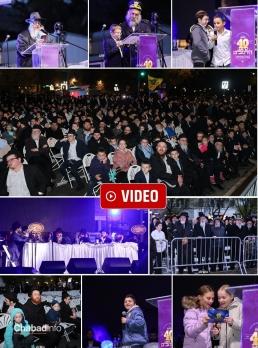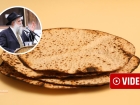Va’eira: The Musical Composition of Transformation to Geula
From the desk of Rabbi Nissim Lagziel, Mashpia in Oholei Torah: This week’s parsha, Vaera, begins with G-d revealing Himself to Moshe. Along with the news about the future redemption from Egypt. The verse is astonishing in its repetitiveness. If G-d wants to inform Moshe that He will stand by the covenant that He Himself made, that could be said in two words or, at most, half the verse. Why must it say: 1) land of Canaan 2) the land of their sojourning 3) in which they sojourned? Why not simply say, “Eretz Yisrael”? • Full Article
By Rabbi Nissim Lagziel, Mashpia in Oholei Torah
BEGIN WITH A GRIN
Avi’s mother wanted him to learn to play the violin but she was afraid that lessons would cost too much. She consulted with her friend.
“Tell me, how much do lessons cost?”
“Lessons are expensive but very profitable!”
“Really? How is that?”
“After three lessons, we were able to buy the condos adjoining ours at half price!”
STEP TO THE MUSIC
This week’s parsha, Vaera, begins with G-d revealing Himself to Moshe. Along with the news about the future redemption from Egypt, in the second verse G-d says to Moshe (6:4), “And also, I established My covenant with them to give them the land of Canaan, the land of their sojourning in which they sojourned.” The verse is astonishing in its repetitiveness. If G-d wants to inform Moshe that He will stand by the covenant that He Himself made, that could be said in two words or, at most, half the verse. Why must it say: 1) land of Canaan 2) the land of their sojourning 3) in which they sojourned? Why not simply say, “Eretz Yisrael”?
What is most disturbing about this repetition are the words,”in which they sojourned.” As the Rebbe’s father, Reb Levi Yitzchok, put it, “If it is the land of their sojourning, obviously they sojourned there.” Why repeat it? There is an important point which the Torah wishes to convey in this wordiness; what is it? And, as always, what can we learn from this in our personal service of Hashem on the eve of the Geula?
The G-dly revelation to Moshe at the beginning of the parsha symbolizes the secret of the Geula. In these verses, G-d reveals to Moshe the true significance of the Geula in general, and the redemption from Egypt in particular. Usually, Chassidus explains that the secret of Geula has to do with the revelation of G-d’s name (the “higher [name] Y-H-V-H”) in the verse, “Therefore, tell the Jewish people that I am G-d” or in the four words for the redemption (v’hotzeisi, v’hitzalti, v’goalti, v’lokachti) that were said afterward. We will try to unearth another allusion relating to the avoda required of us to bring the Geula.
The prophet Malachi calls the Jewish people eretz chefetz (3:12), “And then all the nations shall praise you, for you shall be a desirable land, says the Lord of Hosts.” Chassidus explains that the word “eretz” has a deeper meaning than a piece of land or geographic location. The word eretz is very similar to the words “ratzon” (will, desire) and “ritza” (running) which, on a spiritual plane, means that every Jew “wants” to do the will of G-d and every Jew “runs” to do G-d’s will. There is no Jew who doesn’t want, and no Jew who does not agree; the inner truth of the neshama just needs to be revealed and he will want and even run to do it!
Why is this truth hinted at in the word “eretz”? After all, the verse needs to be understood in its plain sense and the meaning of the word “eretz” is still earth, land.
The reason is that this truth, this uncontrollable desire of every Jew to do the right thing, is something we need to instill within the “eretz,” within the artziyus corporeality, physicality of this world. We need to instill the G-dly will of our neshama into everything and everywhere, at every time and every event. We need to change the world.
There’s the story about the great Chassid of the Tzemach Tzedek who asked the Rebbe in 5617 about traveling (or, more correctly, aliya) to Eretz Yisrael. The Tzemach Tzedek told him, “Reb Hillel of Paritch does not lack Eretz Yisrael and you want Eretz Yisrael. You need to make Eretz Yisrael here,” in the original: mach dah Eretz Yisrael.
The story speaks for itself. We need to take everything which is “chutz l’aretz” (outside of Eretz Yisrael), outside the bounds of holiness, outside the G-dly will, and transform it into “Eretz Yisrael,” to harness the reality of the world and conquer it under the eternal G-dly will.
In an amazing sicha, the Rebbe explains that there are three necessary stages to this avoda, and these three stages are taught to us by the repetition in the verse referred to above.
1-Eretz Canaan represents the state before avoda, the state in which you still need to effect an inner change in the reality of the world and transform “the land of Canaan” to Eretz Yisrael.
2-“The land of their sojourning” represents an intermediate stage, a state in which the negative reality of the world is in an ongoing flux state of transformation. It is transitioning from a state of “land of Canaan” to “land of their sojourning,” a land fit to be the dwelling place of a Jew, a place where it is possible to reveal the supernal intent in the creation of the world.
3- “In which they sojourned” is the optimal state in which “the land of Canaan” becomes the permanent, established place for a Jew and Jewish life. The holiness is implanted in the world in a way that is irreversible, forever! But that’s still not all. Reb Levi Yitzchok adds that the word “Canaan” is an acronym for, “kinor na’im im navel” (a pleasant harp with a lyre). The avoda of “make Eretz Yisrael here” needs to be done like “a pleasant harp with a lyre,” with pleasantness, with sweetness, with joy and pleasure. Because when we serve with a bit (or a lot) of simcha, the avoda is done with chayus and completion.
MUSICAL CRESCENDO
However, the story of the harp and lyre doesn’t end here. These two stringed instruments have a very deep spiritual meaning. As it says in the writings of Kabbala, which explain the verse (which we say every day in Shacharis), “Praise Him with lyre and harp,” without getting into the complicated Kabbalistic discussion about the meaning of the sefiros, the three words, “kinor na’im (im) navel” represent the three, main emotional attributes: chesed, gevura, tiferes.
This Kabbalistic fact comes to teach us a double message regarding the avoda of transforming “the land of Canaan” into Eretz Yisrael. First of all, this avoda needs to be done with feeling and love, with gevura and strength, along with beauty and tiferes. Second, this avoda needs to be done completely, with all three pillars on which the world stands. This means that this avoda includes Torah, tefilla and chessed, such that it is firm and solid on all fronts and on every plane.
And the harp and lyre still have what to say …
The Rebbe explains that through the avoda of “kinor na’im im navel,” by transforming the land of Canaan into Eretz Yisrael with chayus and shleimus, we will merit another sort of harp! It says in the Gemara (Erachin 13b) and it’s explained in Chassidus that the difference between this world and the next world we can learn from the difference between the present harp of this world and the harp of the world to come, the world of resurrection.
The harp of this world has seven strings while the harp of the next world has ten strings, as in the verse (Tehillim 92:4), “Upon a ten-stringed harp and a lyre, with speech upon a harp.” Again a harp, again a lyre, but this time it’s a different type of harp and lyre. These have ten strings which allude to the perfect G-dly revelation of the future.
The word “kinor” in Chassidic terminology is a compound of “ner” – something which represents man, the G-dly soul, as in “the candle of G-d is man’s soul,” and the numerical equivalent of the remaining letters, the chof and vav, twenty-six, which is G-d’s name Havaya. The combination of these two words into one represents the G-dly revelation of the Creator within the soul of a Jew. Or, in other (simpler) words, the greater the “kinor” the greater the revelation of Hashem and the G-dly soul of a Jew.
In this world we merit a partial revelation which is alluded to in the seven-stringed harp. In the next world we will merit a complete revelation which is alluded to in the ten-stringed harp, because we know that the number ten represents perfection. A harp with ten strings represents a complete G-dly revelation, absolutely united with the soul of man and the reality of the world.
So, by the “kinor na’im im navel” now, an avoda complete with all the soul powers in transforming the reality of the world to holiness, we will merit, “Upon a ten-stringed harp and a lyre,” with the true and complete Geula.
TO CONCLUDE WITH A STORY
To end with a fabulous story about the importance of the avoda of “making Eretz Yisrael here.” The night of Simchas Torah 5740, when the Rebbe walked from his tefilla platform to the place of the hakafos, he said to a Jew from Berlin that he should make Lubavitch out of Berlin. When the Rebbe returned from that hakafa, he asked the man, “Five minutes already passed since then. Has Berlin become Lubavitch?”
The next day, Simchas Torah, when the Rebbe returned from the hakafos platform to his tefilla platform, he again said to the man, “Half a day has already passed and what was accomplished?”
If that wasn’t enough, the next day, Isru Chag, this man had yechidus and he asked the Rebbe which language to speak in. The Rebbe told him that he did not remember German so well (though the Rebbe spoke to him in German and Yiddish). The Rebbe said to him, in connection to what was said at hakafos, that if he would involve himself in this with dedication, then others would see and learn from him and even support him. By drawing Jews to Lubavitch, they would be drawn close and return to full Yiddishkeit!
Good Shabbos!
28
Join ChabadInfo's News Roundup and alerts for the HOTTEST Chabad news and updates!








































